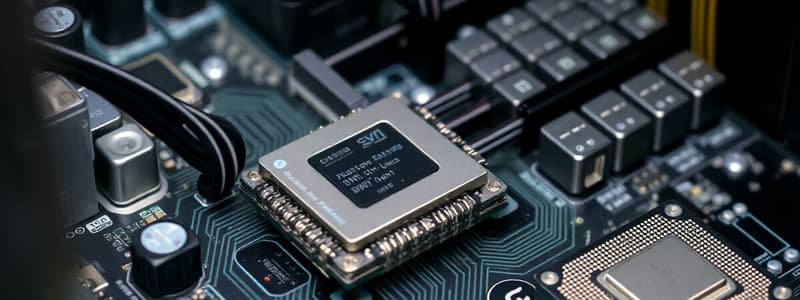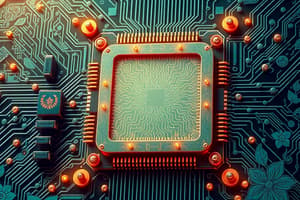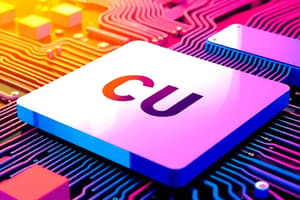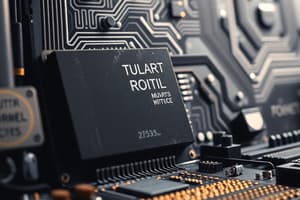Podcast
Questions and Answers
The central processing unit, commonly known as the ______, fetches, decodes and executes instructions, differing inherently from the arithmetic logic unit.
The central processing unit, commonly known as the ______, fetches, decodes and executes instructions, differing inherently from the arithmetic logic unit.
CPU
While both are forms of semi-permanent data storage, the key distinction between a hard disk and solid-state drive (SSD) lies in the absence of moving mechanical components in an ______.
While both are forms of semi-permanent data storage, the key distinction between a hard disk and solid-state drive (SSD) lies in the absence of moving mechanical components in an ______.
SSD
In the hierarchy of memory types, ______ memory stands out for its significantly faster data access speeds compared to regular memory, as it is microchip-based.
In the hierarchy of memory types, ______ memory stands out for its significantly faster data access speeds compared to regular memory, as it is microchip-based.
cache
Optical storage technologies, such as ______ and DVD, utilize lasers to read and write data on rotating discs, each differing in storage capacity and recording capabilities.
Optical storage technologies, such as ______ and DVD, utilize lasers to read and write data on rotating discs, each differing in storage capacity and recording capabilities.
The ______ , a type of volatile memory, stores data temporarily for quick access by the processor, but its contents are erased when the computer is powered off.
The ______ , a type of volatile memory, stores data temporarily for quick access by the processor, but its contents are erased when the computer is powered off.
While a keyboard encodes input through physical key presses, a ______ allows for direct manipulation and interaction with the computer's interface through tactile touch.
While a keyboard encodes input through physical key presses, a ______ allows for direct manipulation and interaction with the computer's interface through tactile touch.
Characterized by their non-volatile nature, ______, such as EEPROM and flash memory, retain stored data even when power is removed, making them suitable for firmware and embedded systems.
Characterized by their non-volatile nature, ______, such as EEPROM and flash memory, retain stored data even when power is removed, making them suitable for firmware and embedded systems.
Distinguished by its reliance on magnetic fields for data storage, a ______ stores binary information on rotating platters, offering high capacity but slower access times than solid-state alternatives.
Distinguished by its reliance on magnetic fields for data storage, a ______ stores binary information on rotating platters, offering high capacity but slower access times than solid-state alternatives.
The term '______' encapsulates the tangible components of a computer system, including both internal parts like the motherboard and external peripherals like the monitor.
The term '______' encapsulates the tangible components of a computer system, including both internal parts like the motherboard and external peripherals like the monitor.
Functioning as a conduit between hardware and software, the ______ contains essential startup instructions and performs initial system checks upon boot-up.
Functioning as a conduit between hardware and software, the ______ contains essential startup instructions and performs initial system checks upon boot-up.
Flashcards
What is Hardware?
What is Hardware?
The physical components of a computer system, including electrical parts and devices that make it up.
What is Processing?
What is Processing?
A procedure that transforms raw data into information. It includes processing, the processor, and main memory devices.
What is a Processor?
What is a Processor?
The device that interprets and executes instructions. Also called the microprocessor, it is the brain of the computer.
What is a CPU?
What is a CPU?
Signup and view all the flashcards
What is Memory?
What is Memory?
Signup and view all the flashcards
What is Cache Memory?
What is Cache Memory?
Signup and view all the flashcards
What is Primary Memory?
What is Primary Memory?
Signup and view all the flashcards
What is ROM?
What is ROM?
Signup and view all the flashcards
What is Random Access Memory (RAM)?
What is Random Access Memory (RAM)?
Signup and view all the flashcards
What are Input Devices?
What are Input Devices?
Signup and view all the flashcards
Study Notes
- Computer hardware consists of the physical components of a computer system
- Hardware refers to the electrical parts and devices making up a computer
Basic Hardware Categories
- Input devices send data to the computer's processor or memory
- Processors fetch, decode, and execute data to turn it into information
- Memory holds the data and instructions needed by the CPU
- Output devices display information and results
- Secondary storage devices store data and information for later use
Computer System Hardware
- Computer systems consist of hardware components like keyboards, mice, monitors, printers, speakers, and the CPU
- Data flows between input devices, the CPU, memory (RAM), and output devices via the Basic Input/Output System (BIOS)
Processing and Processing Hardware
- Processing is procedure that transforms raw data into useful information
- The processor and main memory are processing hardware
- The processor, or CPU, interprets and executes instructions
- The basic function of a CPU is to fetch, decode, and execute instructions held in ROM or RAM
Processor
- The processor interprets and executes instructions and is also called the microprocessor
- A computer's processor is considered its brain
- Faster processor speeds result in faster instruction execution
CPU Operations
- A central processing unit (CPU) executes instructions of a computer program and performs arithmetic, logical, input/output operations
- Microprocessors provide temporary storage for addresses and data
- Microprocessors perform arithmetic and logic operations
- Microprocessors control and schedule all operations
Examples of Processors
- Intel CPUs: Celeron, Pentium III, Pentium 4 (500 MHz – 3.0 GHz)
- Apple/Motorola CPUs: Power G3, G4 (500 MHz – 700 MHz)
- AMD CPUs: K6, K7, Duron, Athlon (500 MHz - 1.5 GHz)
Memory
- Memory refers to the physical devices used to store programs (sequences of instructions), data, text, images, and videos
- Computer memory is the storage space where data to be processed and instructions required for processing are stored
- Memory has three types: cache, primary, and secondary
Cache Memory
- Cache is smaller and faster, storing copies of frequently used data from main memory (RAM)
- Cache acts as a buffer between the CPU and Memory
- Cache holds parts of programs used most often by the CPU
- Computer microprocessors can access cache memory more quickly than regular RAM
Primary Memory (Main Memory)
- Primary Memory has two subcategories: ROM and RAM
- ROM (Read only memory) stores the boot program and information enabling the computer to start up and recognize its hardware
- ROM permanently stores data even when the computer is off and is non-volatile
Read Only Memory (ROM)
- A major function of the BIOS is to identify the boot device (CD-ROM, floppy disk, or hard disk) and transfer the operating system code to RAM
- ROM contains information about the computer's hardware devices
- ROM is faster than secondary memory
Random Access Memory (RAM)
- The area in a computer in which data is stored for quick access by the processor (CPU)
- Data held in RAM is erased when the computer is reset or powered off
- RAM is also called read/write or auxiliary memory
- Computers cannot run without primary memory (RAM/ROM)
(RAM)
- RAM is lost if the computer is turned off
Input Devices
- Input devices are hardware used to enter data into a computer via encoding such as keyboard entry, scanners, or pointing devices like a mouse
- Input hardware converts data into a form that a computer can understand and use
Input Device Examples
- Camera
- Mouse
- Microphone
- Touch tablet
- Keyboard
- Flatbed scanner
Output Devices
- Output devices use display/produce the result of computer's processing of data
- Output provides usable information to the user
- Information presented in a variety of forms depends on the output device
Output Device Examples
- Monitor
- Speakers
- Laser printer
- Multimedia projector
Input & Output devices
- Headphones
- Touchscreen
- Laser Printer
Storage devices
- Data storage devices record (store) information and data
- Hardware storing data for future use are storage devices
- Storage devices found inside or outside the computer system
- Different kinds of storage devices exist
Storage Device Examples
- Magnetic Hard disk/External hard drive/Memory cards
- Optical CD-ROM, DVD (Digital Versatile Disk.)
Hard Disk
- A hard disk is a mass storage device for software applications and data files.
- Hard disks provide a semi-permanent place for data, and possess high capacities
- Hard disks range in size from 80GB to 1TB or 1 PB
- Companies and corporations commonly use Peta Bytes or Zeta Bytes of storage space
CD-ROMs (COMPACT DISC READ ONLY MEMORY)
- Optical storage devices
- CD-ROM’s read and write data, using lasers
- CD-ROMs can store up to 650MB to 700MB of data
CD-R and CD-RW
- CD-R (CD-Recordable) discs record can not be rewritten.
- CD-RW allows erase and rewrite without loss of space
DVD and rewritable DVD
- DVD (Digital Versatile Disc) optical discs share same overall dimensions of a CD with higher capacities
- DVD+RW allow data storage and digital video recording onto 4.7 GB
- Rewritable DVD are still in infancy
Studying That Suits You
Use AI to generate personalized quizzes and flashcards to suit your learning preferences.



